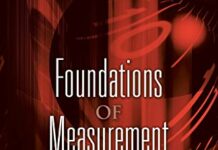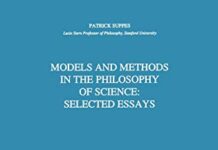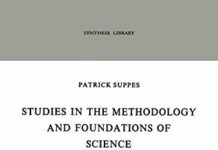
Ebook Info
- Published: 2001
- Number of pages: 200 pages
- Format: PDF
- File Size: 7.69 MB
- Authors: Patrick Suppes
Description
A fundamental reason for using formal methods in the philosophy of science is the desirability of having a fixed frame of reference that may be used to organize the variety of doctrines at hand. This book—Patrick Suppes’s major work, and the result of several decades of research—examines how set-theoretical methods provide such a framework, covering issues of axiomatic method, representation, invariance, probability, mechanics, and language, including research on brain-wave representations of words and sentences. This is a groundbreaking, essential text from a distinguished philosopher.
User’s Reviews
Editorial Reviews: About the Author Patrick Suppes is the Lucie Stern Professor of Philosophy, Emeritus at Stanford University.
Reviews from Amazon users which were colected at the time this book was published on the website:
⭐The book was delivered very quickly and in truly excellent condition. (The 5 stars are for this aspect and not the content but it is also excellent — Pat Suppes died recently and this is the culmination of his life’s work in the philosophy of science.)
⭐First, in the interests of full disclosure: 1) Patrick Suppes is one of my advisors; 2) I have only read the first half of this book closely (though I’ve read the first half twice, extremely closely both times). Normally I would never write a review for a book I haven’t completed, but it struck me as such a crime that no review had been written yet for this book, that I thought I would go ahead and put one up.This is a seminal work by the philosopher of science Patrick Suppes. In philosophy of science, Suppes is important (amongst other things) for initiating the “semantic” approach to theories. The semantic approach rejects the treatment of theories as a collection of sentences in some formal language (the syntactic approach) in favor of a view which interprets theories as set theoretical structures (the terminology will be obvious to any student of logic). Suppes initiated the semantic approach in a series of papers in the early 1960s. Since then, a number of philosophers have advocated the approach, but the majority of them wander from the original motivation. As is made clear in this book, the motivation behind treating theories as set theoretic structures is the ease with which precise statements about the relationship between different theories can be stated.In line with this project, the first four chapters outline Suppes’ general perspective. After defending the representation of theories in set theoretical terms, Suppes discusses the key notions of isomorphism and invariance. Isomorphism (more generally, homomorphism) is the appropriate formal notion for rigorously connecting two set theoretical structures (i.e. theories). The most interesting case for philosophy of science occurs when a representation theorem of some qualitative structure, defined via axioms, is given in a mathematical structure. An important special case of this can be found in measurement theory (c.f. another of Suppes’ seminal works,
⭐) where one wishes to provide a representation theorem for a qualitative procedure defined via axioms (say, one analogous to holding a ruler up against sticks of different lengths) into a mathematical structure (say, the real line). Such a representation will provide justification for assigning real numbers to measurements.Once one has provided such a representation theorem, what is left? Here is where the concept of invariance is crucial. The invariants of a structure under transformation define its essential content. For example, measurements of length in terms of inches or centimeters are distinct from measurements of temperature in terms of degrees Celsius or degrees Fahrenheit. Why? Because length measurements depend upon choosing an arbitrary scale, whereas temperature measurements depend upon determining both and arbitrary scale *and* an arbitrary origin point (i.e. the zero degree point). This means that length measurements will remain invariant under some transformations that temperature measurements will not remain invariant under.The crucial aspect of this approach, which distinguishes it from most work in philosophy of science, including most other attempts at a semantic approach, is that *everything* is a set theoretic structure. So, for example, much of philosophy deals with the relationship between scientific theories and the world. For Suppes, we can make this question precise only in so far as we can define either side of the relationship in set theoretic terms. So, first we ask about the relationship between a theory and the canonical model of the data for that theory, both of which can be defined as set theoretic structures. Next, we make the model of the experiment increasingly precise. This precision, however, involves including more and more details of the experiment into the model, eventually including the judgments of the experimenting scientist himself. At this point, our model has wandered into other scientific theories without ever involving some independent notion of “the world.” The whole project here is motivated by working within a format within which questions can be answered in a precise manner: we only have a *precise* model of the world insofar as we have data about it, and we can only make this model more precise by adding details about the procedure by which data was collected. This means that our models will never bottom out in some experimenter-independent world, but increasingly precise models of experimental data will always, at some point, include the experimenter himself.After the first four chapters, the rest of the book give examples of this methodology in various domains, from probability to mechanics and language. I admit that the only part of this section I have read closely is the chapter on probability. This chapter by itself, however, is worth the price of the book. After presenting the formal theory of probability, Suppes presents six distinct philosophical interpretations, proving a representation theorem for each. He concludes with an argument for pragmatism about probability. In these 135 pages, Suppes offer a more concise, yet thorough, precise, yet intuitive motivation of the appeal of and problems for the major philosophical interpretations of the probability calculus than I have seen anywhere (speaking as a philosopher of probability). If you read and understand this chapter, you will already be miles ahead of the majority of philosophers working in the field. If you are mathematically inclined, this chapter constitutes a self-contained textbook in probability.I cannot comment seriously on the remainder of the book, but a number of diverse examples of (Suppes’ version of) the semantic approach are given. A total omission is discussion of the foundations of statistics. This topic provides the crucial link between Suppes’ approach and many of the traditional concerns in philosophy of science. If phil sci is interested in the relationship between and theory and world, and Suppes replaces this with the relationship between theory and canonical model of data, than the critical aspect of Suppes’ discussion should be on this relationship. It is precisely here, however, that the foundations of statistical inference are relevant, as the relationship between theory and data is fundamentally statistical in character. Unfortunately, Suppes omits discussion of this topic.Style: Suppes’ style suffers from two detriments. First, it is formal to a fault. This is only a detriment to the usual philosopher of science who does not have the Suppesian acumen for formal work. Furthermore, in a sense, this is not a detriment at all, because the formal nature of the work is what solidifies its standing as a significant contribution to our understanding of science. Nevertheless, readers who are unfamiliar with set theory or scared by equations and formulae will find little appealing in this book.Second, and much more importantly, Suppes exhibits a tendency to skip steps in his arguments which would usually be explicitly stated in the philosophy of science. For example, the discussion offered above for the relationship between theory and world does not come from the book, but my interpretation of it.Final assessment: this is a seminal work in the formal philosophy of science. On the one hand, it will make little sense to any philosopher of science who is not willing to engage in serious formal work, on the other hand, any such philosopher will have to ask himself what the heck he thinks he is saying about mathematical theories if he is not willing to himself engage on the metalevel in the type of precision the theories on which he himself comments have engaged. Suppes at least has taken up this challenge. Even if the conclusions of this work are unclear, it is undeniably a major contribution to the thorough and detailed understanding of this difficult topic.
Keywords
Free Download Representation and Invariance of Scientific Structures (Lecture Notes) 1st Edition in PDF format
Representation and Invariance of Scientific Structures (Lecture Notes) 1st Edition PDF Free Download
Download Representation and Invariance of Scientific Structures (Lecture Notes) 1st Edition 2001 PDF Free
Representation and Invariance of Scientific Structures (Lecture Notes) 1st Edition 2001 PDF Free Download
Download Representation and Invariance of Scientific Structures (Lecture Notes) 1st Edition PDF
Free Download Ebook Representation and Invariance of Scientific Structures (Lecture Notes) 1st Edition



